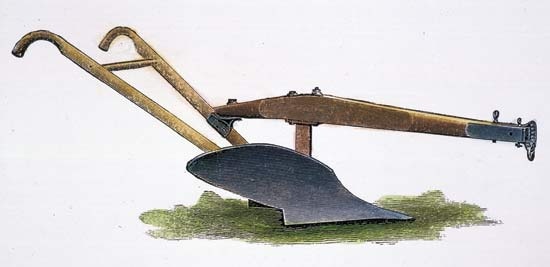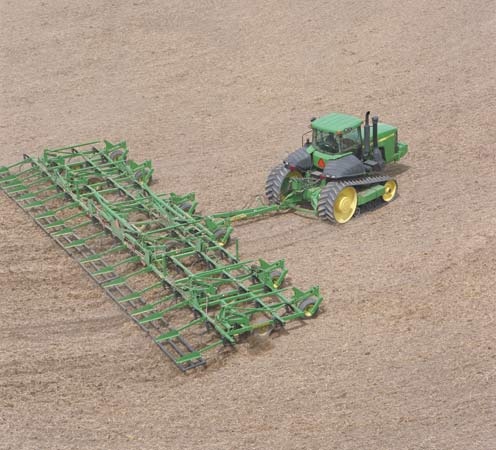plow
agriculture
also spelled plough
 most important agricultural implement since the beginning of history, used to turn and break up soil, to bury crop residues, and to help control weeds.
most important agricultural implement since the beginning of history, used to turn and break up soil, to bury crop residues, and to help control weeds.The antecedent of the plow is the prehistoric digging stick. The earliest plows were doubtless digging sticks fashioned with handles for pulling or pushing. By Roman times, light, wheelless plows with iron shares (blades) were drawn by oxen; these implements could break up the topsoil of the Mediterranean regions but could not handle the heavier soils of northwestern Europe. The wheeled plow, at first drawn by oxen but later by horses, made possible the northward spread of European agriculture. The 18th-century addition of the moldboard, which turned the furrow slice cut by the plowshare, was an important advance. In the mid-19th century the black prairie soils of the American Midwest challenged the strength of the existing plow, and American mechanic John Deere (Deere, John) invented the all-steel one-piece share and moldboard. The three-wheel sulky plow followed and, with the introduction of the gasoline engine, the tractor-drawn plow.
In its simplest form the moldboard plow consists of the share, the broad blade that cuts through the soil; the moldboard, for turning the furrow slice; and the landside, a plate on the opposite side from the moldboard that absorbs the side thrust of the turning action. Horse-drawn moldboard plows, which are no longer commonly used, have a single bottom (share and moldboard), while tractor-drawn plows have from 1 to 14 hydraulically lifted and controlled bottoms staggered in tandem. Listers and middlebusters are double-moldboard plows that leave a furrow by throwing the dirt both ways.
 Disk plows usually have three or more individually mounted concave disks that are inclined backward to achieve maximum depth. They are particularly adapted for use in hard, dry soils, shrubby or bushy land, or on rocky land. Disk tillers, also called harrow plows or one-way disk plows, usually consist of a gang of many disks mounted on one axle (see harrow). Used after grain harvest, they usually leave some stubble to help reduce wind erosion and often have seeding equipment. Two-way (reversible) plows have disks or moldboards that can be either opposed, so that one fills the trench made by the other, or set to throw the soil entirely to the right or left.
Disk plows usually have three or more individually mounted concave disks that are inclined backward to achieve maximum depth. They are particularly adapted for use in hard, dry soils, shrubby or bushy land, or on rocky land. Disk tillers, also called harrow plows or one-way disk plows, usually consist of a gang of many disks mounted on one axle (see harrow). Used after grain harvest, they usually leave some stubble to help reduce wind erosion and often have seeding equipment. Two-way (reversible) plows have disks or moldboards that can be either opposed, so that one fills the trench made by the other, or set to throw the soil entirely to the right or left.Rotary plows or tillers (sometimes called rototillers) have curved cutting knives mounted on a horizontal power-driven shaft. The pronged rotary hoe, a plow used chiefly for seedbed and weed control, works well at high speed. Garden sizes cut swaths from 1 to 2.5 feet (about 0.33 to 0.8 metre) wide; tractor types, more than 10 feet.
 Deep tillage implements, used chiefly to break up hardpan and packed soils, include the subsoiler and the chisel plow. The subsoiler must be pulled by a heavy tractor, for its steel-pointed shank is capable of penetrating the subsoil to a depth of three feet. The chisel plow, or ripper, has several rigid or spring-toothed shanks with double pointed shovels mounted on a transverse bar at intervals of one to three feet. Plowing depths vary from a few inches to 1.5 feet.
Deep tillage implements, used chiefly to break up hardpan and packed soils, include the subsoiler and the chisel plow. The subsoiler must be pulled by a heavy tractor, for its steel-pointed shank is capable of penetrating the subsoil to a depth of three feet. The chisel plow, or ripper, has several rigid or spring-toothed shanks with double pointed shovels mounted on a transverse bar at intervals of one to three feet. Plowing depths vary from a few inches to 1.5 feet.- François de Bonne, duc de Lesdiguières
- François de Bonne Lesdiguières, duc de
- François de Bourbon Conti, prince de
- François de Bourbon, prince de Conti
- François de Callières
- François de Curel
- François de Cuvilliés, The Elder
- François de La Mothe Le Vayer
- François de La Noue
- François de La Rocque
- François de Malherbe
- François de Montmorency Laval
- François de Neufville, duc de (duke of) Villeroi
- François de Neufville Villeroi, duc de (duke of)
- François de Salignac de La Mothe- Fénelon
- François de, The Elder Cuvilliés
- François de Vendôme Beaufort, duc de
- François de Vendôme, duc de Beaufort
- François, duc d' Anjou
- François, Duke de Montmorency
- François Dumont
- François Duquesnoy
- François Duvalier
- Françoise-Athénaïs de Rochechouart, marquise de Montespan
- Françoise-Athénaïs de Rochechouart Montespan, marquise de